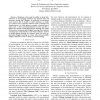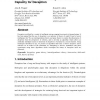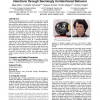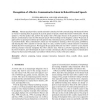279 search results - page 35 / 56 » Social robotic telepresence |
ICRA
2007
IEEE
14 years 1 months ago
2007
IEEE
— Ubiquitous robots need the ability to adapt their behaviour to the changing situations and demands they will encounter during their lifetimes. In particular, non-technical user...
IJSR
2011
13 years 2 months ago
2011
Deception is utilized by a variety of intelligent systems ranging from insects to human beings. It has been argued that the use of deception is an indicator of theory of mind [2] ...
HRI
2009
ACM
14 years 6 days ago
2009
ACM
Human communication involves a number of nonverbal cues that are seemingly unintentional, unconscious, and automatic—both in their production and perception—and convey rich in...
AROBOTS
2002
13 years 7 months ago
2002
Human speech provides a natural and intuitive interface for both communicating with humanoid robots as well as for teaching them. In general, the acoustic pattern of speech contain...
HRI
2009
ACM
14 years 2 months ago
2009
ACM
Psycholinguistic studies of situated language processing have revealed that gaze in the visual environment is tightly coupled with both spoken language comprehension and productio...




